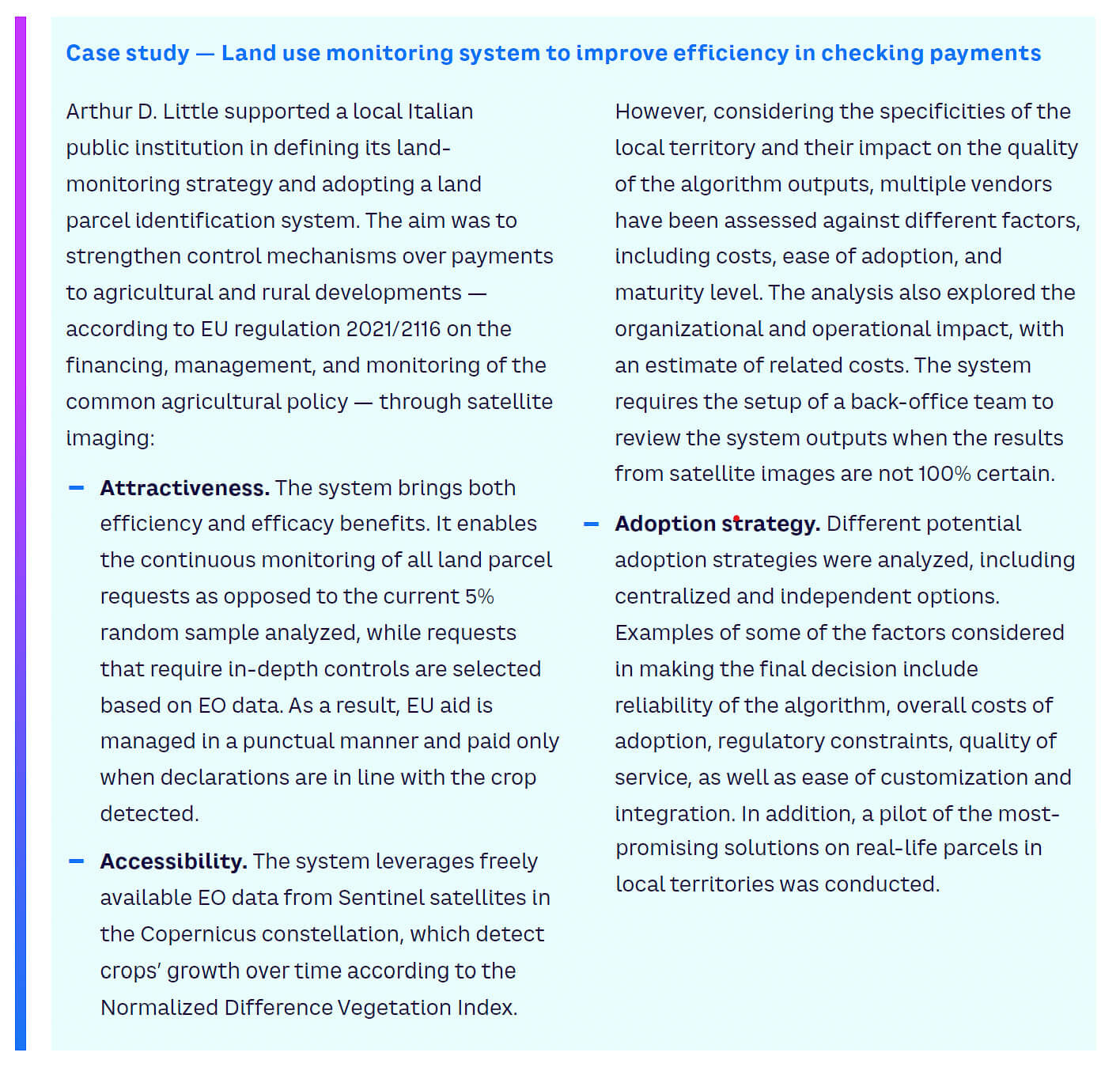
Earth observation (EO) — combined with developments in cloud infrastructure, big data, and artificial intelligence (AI) — enables data-driven decision-making to address societal challenges like city development planning, land management, and climate issues. Higher data resolution fostered by technology enhancement, increased access to free low-/medium-resolution images, easily accessible computing power, and accelerating data-driven organizational transformation have enabled steady growth in EO market. This Viewpoint analyzes potential applications and barriers, shedding light on how private and public organizations could grasp value.
DATA-DRIVEN DECISION-MAKING IS KEY TO ADDRESSING SOCIETAL CHALLENGES
Converging developments in cloud-based infrastructures, big data, and AI, plus a considerable reduction in the cost of space systems, have created an unprecedented opportunity to boost the adoption of data-driven applications in response to a variety of societal challenges. These include monitoring scarcity of resources, mitigating climate change and environmental degradation, tracking migration flow, and monitoring the acceleration of urbanization and rural area development.
EO is a key enabler of data-driven decision-making in this context, allowing information gathering on atmospheric constituents and climate indicators by cross-referencing satellite data with available environmental and demographic information. Big data collected from multiple sources, including satellites, can support, for instance, migration flow monitoring and detection of illegal activities. Furthermore, EO provides timely and spatially disaggregated information useful to city development planning and land management.
The current low adoption of EO is due mainly to the high costs of data acquisition and processing, limited availability of exploitable data, shortage of skills, and an inertia to embrace change. However, recent technological developments are opening up opportunities to develop and introduce new services (see, for example, sidebar “IRIDE: A new Italian EO constellation”). Indeed, following the EU’s Copernicus EO program, several European member states have recognized the value of EO’s data potential and are investing in initiatives to facilitate the adoption of EO in both public and private sectors.
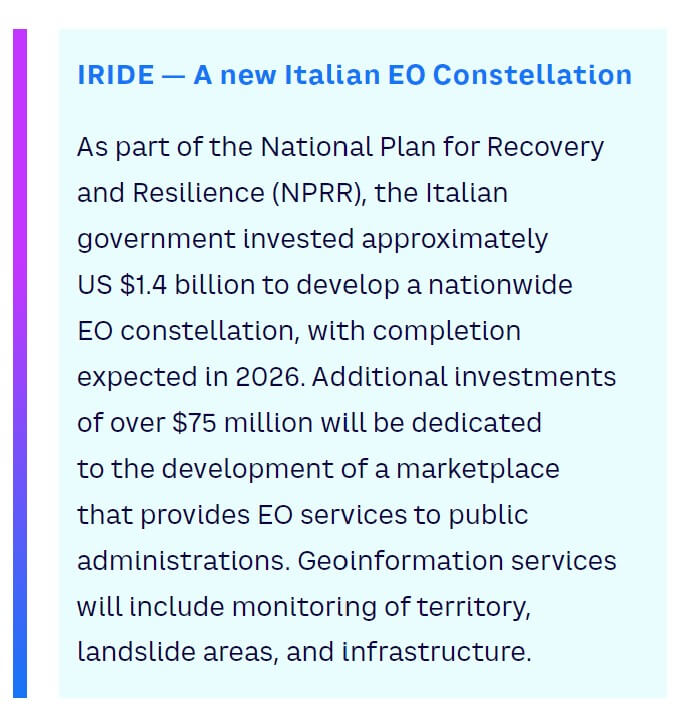
Improved availability of high-quality EO data
In recent years, the EO market has witnessed steady growth supported by four main drivers:
-
Higher resolution of commercial data due to improvements in remote sensing technologies and constellations
-
More accessible commercial images coupled with free low-/medium-resolution data post-Copernicus
-
Easily accessible and scalable computing power for data processing and analytics through cloud technologies
-
Accelerating data-driven transformation of organizations
Remote sensing applications have specific requirements in terms of type of sensor (the most adopted are optical/multispectral and synthetic aperture radar, while other technologies include infrared and radio frequency), resolution, and revisit time (i.e., the time elapsed between observations of the same point on Earth). And historically, the cost of data has been a key barrier to adoption. However, reductions in the cost of access to space (including satellite manufacturing and launch costs) coupled with better-performing sensors have increased the supply of commercial satellite imagery while reducing data prices considerably.
Institutional constellations, such as Copernicus and the future IRIDE, which offer free EO data, have been a major step in the adoption of EO applications, particularly those characterized by less-stringent requirements. Furthermore, increased digitalization is promoting a shift toward data-driven processes and decision-making and enabling more widespread use of EO data. Developments such as cloud-based storage and computing, coupled with a greater availability and accessibility of innovative AI/machine learning (ML) algorithms, are enabling public bodies and private companies to process and analyze large amounts of data more efficiently. And as AI increasingly turns into a commodity, it represents an enormous opportunity for societies, governments, and businesses to collect and analyze data from sources including drones, satellites, and Internet of Things. In this context, organizations are revealing a growing willingness to create an environment where all business structures are empowered to make complex data-driven decisions and where data and analysis tools are widely accessible across the entire organization.
Understanding end-user needs & measuring value of EO applications
EO offers a variety of services for both the public and private sectors, including monitoring of land and coastal/marine areas, meteorological and climate forecasting, decision-making support in emergency situations (e.g., rapid damage mapping), and surveillance services (e.g., vessel tracking).
The first step in adopting satellite-based EO services is to assess the value that such services can bring. On the one hand, public and private organizations should measure the suitability of EO applications by applying a multi-criteria system that considers economic benefits (e.g., increased efficiency through cost reduction), social and environmental impacts, and regulatory implications. On the other hand, organizations should also consider the cost of adoption, including the maturity of the algorithms and cost of images. The net value to end users depends on the specific use case and the unique context of the application.
In public administrations (PAs), authorities should proceed with periodic high-level screening to exploit emerging EO applications and perform deep dive assessments on the most promising ones. Figure 1 illustrates the impact and potential applicability of EO services and satellite applications in the public sector.
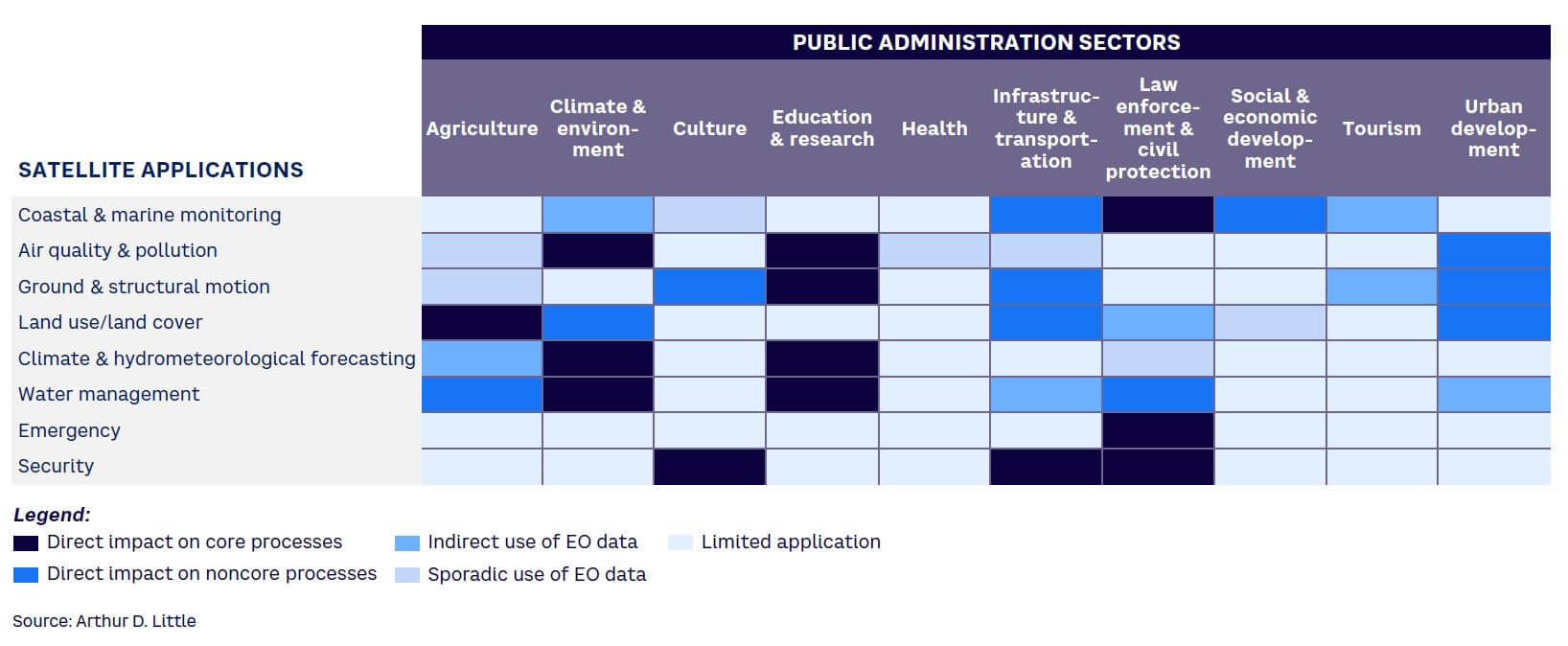
Ongoing barriers to adoption
Despite the growth in EO services, there are still adoption barriers to overcome, including:
-
Lack of awareness. PAs and private enterprises are not always aware of the numerous benefits that EO can bring in terms of savings and increased value in the delivery of higher-quality community services.
-
Funds access. The development and evolution of current technologies require investment in both IT systems and data-governance processes in order to exploit advanced analytic techniques based on ML/AI algorithms. Public and private companies could face high costs in order to benefit from EO-based data. Local administrations, for instance, are highly fragmented, with large budgets often managed by central authorities, making it difficult for small local administrations to access these funds.
-
New skills development. New skills and capabilities are necessary for organizations to collect insights from EO data, ranging from knowledge of satellite remote sensing technologies to advanced analytics techniques. AI and ML enable raw data collected by satellites to be turned into information usable by PAs and companies.
Following the Copernicus constellation’s deployment, European and national institutions have invested in increasing the awareness of EO’s potential and facilitating its adoption within PAs. Yet, despite the high level of automation in the first steps of the EO value chain (see Figure 2), human intervention and deep domain knowledge are still required to develop and tune data analytics algorithms. In the future, the commoditization of AI and ML could reduce the need for technical expertise, particularly for less complex use cases, although domain-specific knowledge will likely still be required.
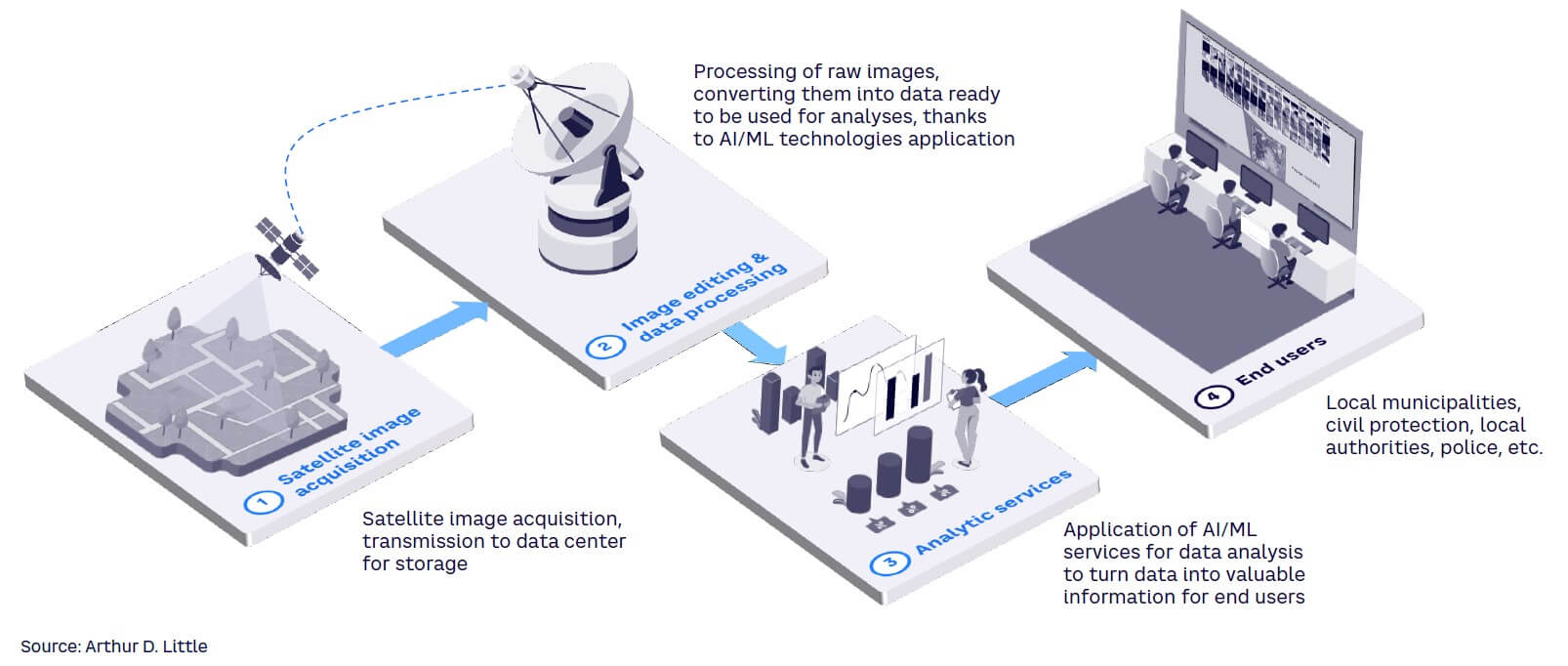
A tailored adoption model
Three models have been identified to support the exploitation of EO and reduce adoption barriers (see Figure 3):
-
Independent/ad hoc. The independent model focuses on one specific use case (e.g., land parcel identification in the context of the EU’s Common Agricultural Policy). It is used primarily when an innovative solution is needed and cannot be found on the market or where specific local conditions require heavily customized algorithms. In such scenarios, the level of integration along the EO value chain tends to be low, as it depends mainly on the provider selected, which will often focus on the analytic services provision itself. This model is characterized by limited economies of scale, as the use case is usually adopted by a single administration or private company requiring specific customization and quality
of service. -
Centralized. Centralized models are developed for a specific application, but they are managed by a central entity providing an end-to-end service. The centralized model focuses on mature use cases adopted by several end users, and local conditions have a limited impact on algorithms. This model partially unlocks economies of scale on the purchase of EO images, and the service is usually financed by the central authority. In this case, the quality of service depends on the central entity, which the individual end user might have limited control over.
-
Marketplace. This model offers a digital ecosystem, including a relevant hardware and software infrastructure, enabling the space industry to offer EO data (both archived and on demand), applications, and services. PAs and private companies benefit from cost-effective solutions thanks to the presence of an anchor customer (i.e., the main institutional users) and transactions directly managed by the system. The platform offers multiple use cases in one single place, focusing on easily replicable services with limited customization required. This model is designed to integrate the entire EO value chain, from data access to final services. The quality of service depends on the supplier, over which the individual user might have limited control, as well as the capabilities of EO. As such, the level of skills required by PAs and private companies is likely to be very limited.
There is no “one size fits all” adoption model. However, the most suitable one can be selected depending on requirements. Alternatively, organizations may design a “fit for purpose” model.
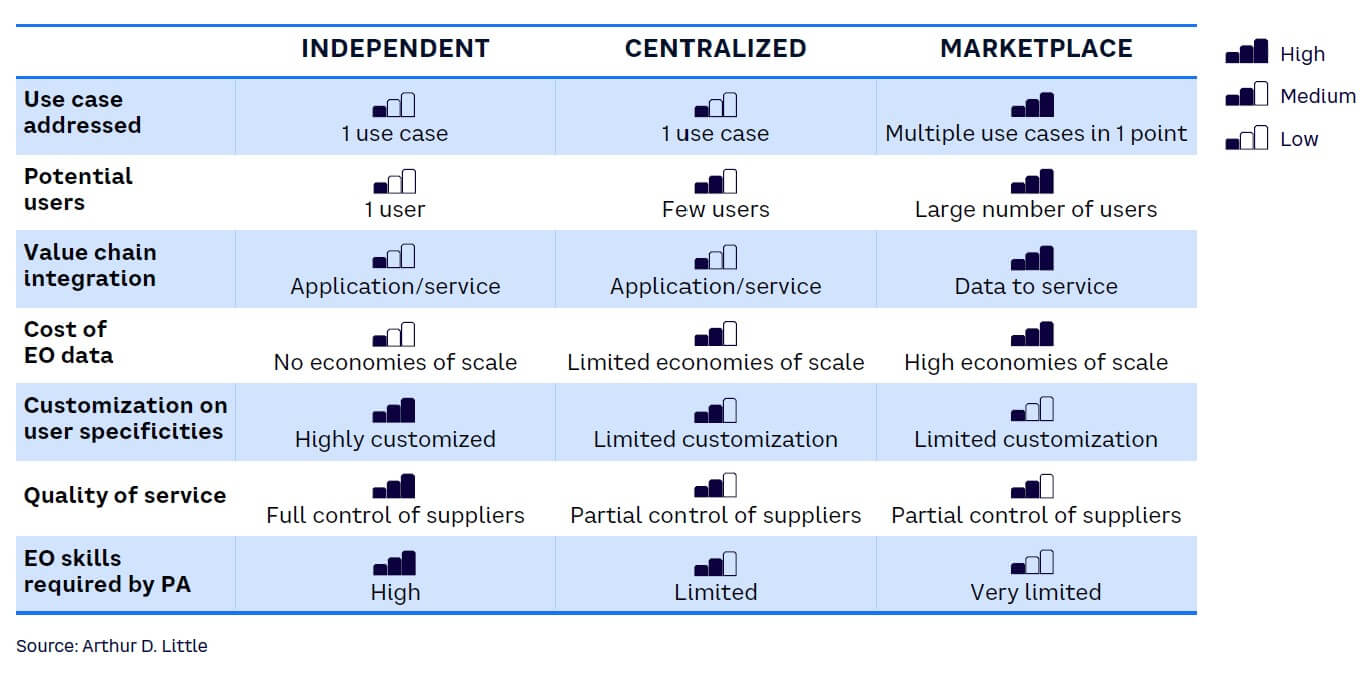
Conclusion
REACHING for THE SKY
Recent developments in the EO sector are opening up new opportunities for
both public administrations and private companies. EO applications are a valuable asset for monitoring and managing key trends, including urbanization, border security, climate change, air quality, and water management. To embrace EO and accelerate its adoption, administrations and companies should take some
key steps, including:
-
Define a strategic rationale for EO implementation by evaluating possible applications and assessing expected benefits of EO services implementation, coupled with advanced technologies development.
-
Assess current strategies, technologies, and processes to identify gaps and map ideal perimeters, as well as to define ideal implementation model.
-
Identify priorities that can add value to current operations while building consensus within the institution and defining a clear implementation roadmap.
-
Identify required digital technologies and IT infrastructure to facilitate integration of data analytics to fully exploit EO potential, while ensuring security.
-
Redesign processes, roles, and competencies required to adopt EO within public or private context, defining governance principles and adapting them to new processes.
-
Define plan to build/nurture required skills and capabilities related to digital transformation and advanced technologies, as well as developing change management activities to overcome resistance.
-
Define strategy execution, engaging large panels of stakeholders involved and leveraging the support of experts in solutions procurement, IT systems development, and processes adoption.
-
Design monitoring process to assess gradual implementation of EO and continuously identify new possible adoptions.





